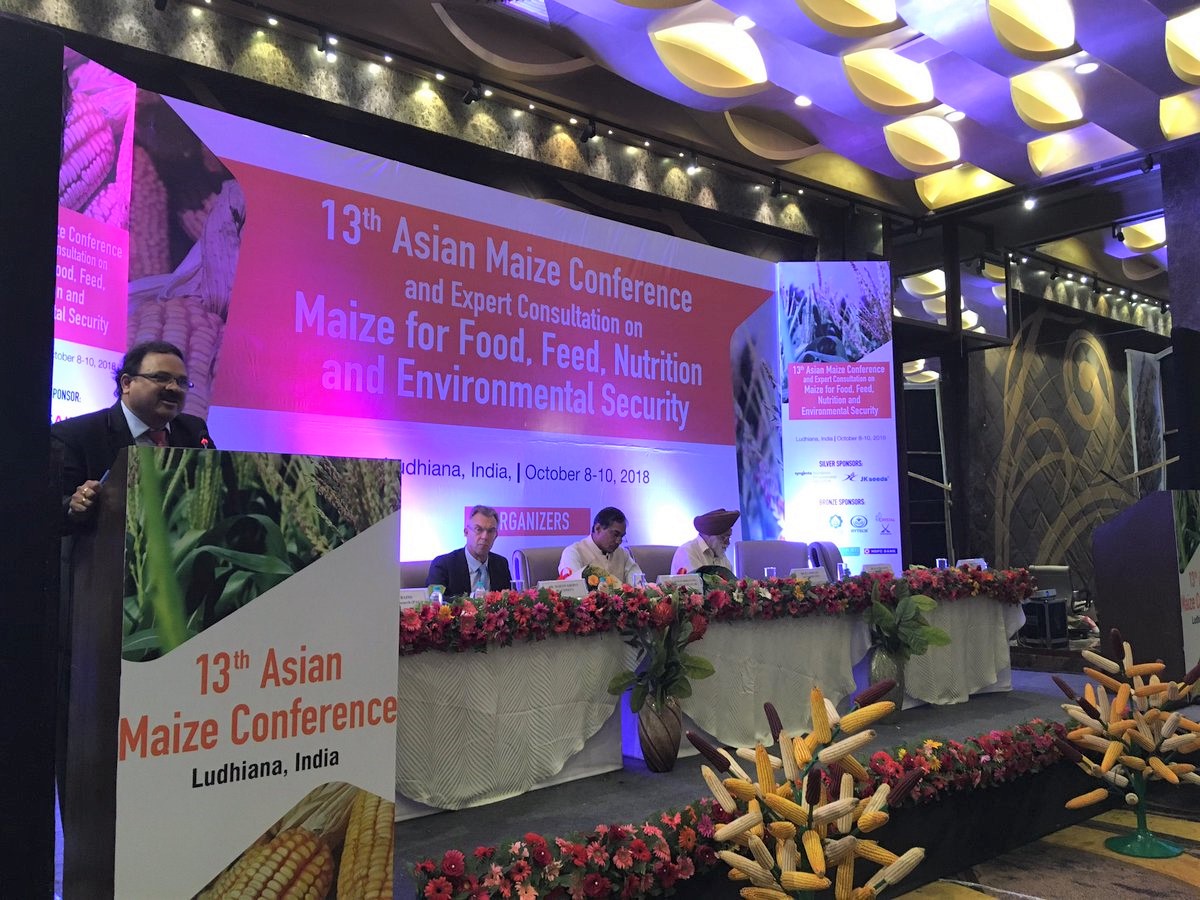
13th Asian Maize Conference launched in Ludhiana, India
by Jennifer Johnson
International experts on maize have gathered in Ludhiana, Punjab, India, for the 13th Asian Maize Conference and Expert Consultation on Maize for Food, Feed, Nutrition and Environmental Security. The conference, being held from October 8-10, 2018, has attracted over 280 participants from 20 countries. The delegates come from a broad range of stakeholders, including researchers, policy makers, seed companies, service providers, innovative farmers, and representatives of several development organizations and funding agencies.

In the opening ceremony on October 8, B.M. Prasanna, the Director of the Global Maize Program at the International Maize and Wheat Improvement Center (CIMMYT) and the CGIAR Research Program on Maize (MAIZE), discussed the current situation of maize in Asia as well as the themes of the conference. A diverse range of relevant topics will be covered, from breeding for climate resilience in maize based systems and climate-smart agriculture to socioeconomics for greater impact. “Gender and social inclusion is an important issue not only for Asia, but for the entire world. Women play a very important role in our farming systems, but women’s access to improved inputs such as seed is very low. All communities, regardless of caste or creed, need access to these inputs,” he said. The need for scale appropriate mechanization and the importance of public private partnerships will also be discussed.
Another topic of interest is that of the fall armyworm, an invasive insect pest that has spread through 44 countries in Africa and was recently reported in India for the first time. “This pest can migrate very quickly, and doesn’t require visas and passports like we do. It will travel, and Asian nations need to be prepared,” said Prasanna. “However, there is no need for alarm—we will be looking at lessons learned from other regions, and will work together to control this pest.”
Maize in Asia has high productivity and high demand, with maize productivity in the region growing by 5.2% annually as compared to a global average of 3.5%. However, this is not enough. “Asia produces nearly 80 million tons of maize annually, but demand will be double by the year 2050,” said Martin Kropff, CIMMYT director general. “We need to produce two times more maize in Asia, using two times less inputs, and it needs to be two times more nutritious. Climate change will make this more difficult. Continued funding for maize research is crucial. We need to work together to ensure that this research and innovation gets to farmers.”
In his welcome remarks N.S. Bains, director of research at Punjab Agricultural University, expressed his pleasure that the conference would be held in India for the second time, after 24 years. “What brings us together today is maize, a crop with an evolution bordering on the magical, that belongs even more to the future than to the past. Now maize leads the way in crop genomics. We are looking to use maize to solve many current challenges, which will be the theme of this conference,” he said.
Trilochan Mohapatra, the director general of the Indian Council of Agricultural Research (ICAR) discussed in detail the situation of maize in India. The country produces 25-27 million metric tons of maize per year, yet low productivity for “kharif” (rainfed) season remains a challenge. “We have continuously enhanced maize productivity in India since the times of great food insecurity in the 1950’s, and have tremendous scope to improve using new technologies, such as marker assisted selection for quality in maize,” he said.
Sujay Rakshit, director of the ICAR-Indian Institute of Maize Research gave a vote of thanks to the conference organizers and particularly the funders that made the event possible.

At the conclusion of the opening remarks, the Organizers presented Dr B.S. Dhillon, vice-chancellor of Punjab Agricultural University, with the MAIZE Champion for Asia Award for his pioneering work in maize breeding throughout his career. “We are so lucky to work with a crop that has contributed so much to humanity. No other crop can compare,” Dhillon said in his address to participants. He also discussed the importance of climate resilient maize varieties to help smallholder farmers suffering from the effects of climate variability.
The remainder of the conference will address the main opportunities and challenges for maize in Asia through technical sessions covering diverse topics such as novel tools and strategies for increasing genetic gains, specialty maize, processing and value addition, and nutritionally enriched maize for Asia, among others.
On Wednesday, October 10, a field day will be held at the BISA farm in Ladhowal, Ludhiana for conference participants. Nearly 100 improved maize varieties developed by CIMMYT, ICAR and public and private sector partners will be on display, in addition to scale appropriate mechanization options, precision nutrient and water management techniques, decision tools, sensors and automation-based management systems.
At the close of the conference, the winners of the 2018 MAIZE-Asia Youth Innovators Award will be announced, and will be given the opportunity to present on their research. The awards were launched in collaboration between MAIZE and YPARD (Young Professionals for Agricultural Development) to recognize the contributions of innovative young women and men who can inspire fellow young people to get involved with maize-based agri-food systems.
The conference program and details are available at www.maizedev.projects.cimmyt.org.
